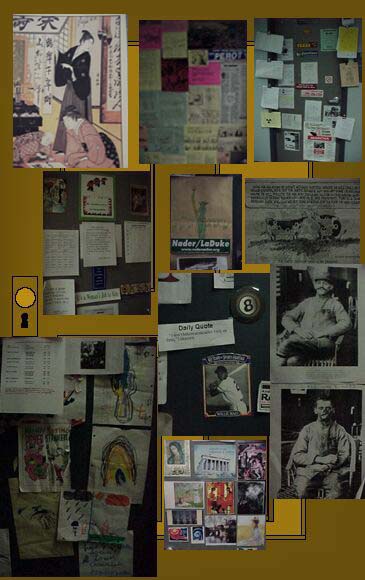
If the eyes are the window
into our soul, then a faculty member’s door may be the opening into their
reality.
Some doors are used
as political walls to express opinions. Others post events to keep students
informed. A couple of clever quotes cover the rest. Seven doors, however,
required special attention.
One of the doors is located in the Faculty Office Building, Room 116. The door, which demands reading all the quotes,comics and
articles, belongs to Bob Richmond, Assistant Professor of English. Three-fourths of the door is plastered with articles and comics
Richmond’s
door has an ironic comic with two devils trying to inflict punishment on a happy
worker. Grammar-related comics are also scattered throughout the door.
“Offices, I think do reflect, as do doors, the person inside,”
said Richmond. “The person who occupies the space. So I want my spaces
a little messy, but it’s comfortable.”
Down Richmond’s
hall, the other doors had an average amount displayed, except for the
one that belongs to Alfredo Gil Alvarez Jr.,Assistant Professor of Mathematics
in FOB, Room 126.
Alvarez’s door
had gigabytes of mathematical information arranged in interesting scenarios.
The mathematical problems Alvarez presents are embedded in real-life problems.
The outer lining of the door is completely laced with assignments and
practice finals for students in his courses.
In his office, a mountain
of boxes blocks visitors into following a slanted path, which leads to
his seat. Everything he needs is within arm’s reach.
Further down the hall from Alvarez in the FOB, Room 133, was a door without
quotes or articles, but its art told a thousand stories. This door belongs
to Ellen Shull, Professor of English.
Most of the art and photos on her door are Hallmark-sized. Shull gets
her art from brochures and magazines.
On her door, you will find a variety of pictures from the Virgin of Guadalupe
to detailed finger paintings. A Japanese picture and a futuristic city
can also be found in the mix. A photograph of flowers from New Mexico
is on her door, along with a particular photo that sparked some keen attention.
“When I Turned Around,” by Cecilia Michelon is the photo, and
it was on the cover of an English journal.
A building away, in
General Education, Room 241, the next door to visit belonged to Karen
Marcotte, Professor of Humanities/IDST.
Marcotte’s door
is filled with items from a variety of newspapers and comics that disturb
or interest her. She copies and blows up many tidbits on her door. There
is a quirky comic about Mad Cow Disease. Motivational quotes are also
scattered on her door.
In Marcotte’s
office, the most interesting thing is a sticker labeled ‘Eracism.’
Eracism is an organization in New Orleans founded by women who helped
bring tranquility to a mixed ethnicity problem through drug awareness
and literacy programs.
On the other side
of campus in the Social Science Building, Room 117, there is a door that
belongs to Norman “Louie” Armstrong, Instructor of History.
Armstrong’s door
has two sheets that are devoted to famous quotes from former Presidents
and First Ladies. Pictures and articles of Willie Mayes are also there.
Quotes and a humorous day-to-day philosophy are on his door. Pictures
and articles of the Kennedy family also are on his door.
Armstrong also lives
and dies by this quote, “I don’t believe in miracles…I
rely on them.”
Further down the hallway,
Room 123, is Peter Myers, Assistant Professor of History, who has a disturbing
picture of a World War I veteran displayed.
The veteran has most
of his face blown off. Another image of the same man is positioned above
it, and it shows a skillfully made face covering the disfigurement. There
are also some political comics that express what war is really about and
who we should really fear. A Statue of Liberty crayon drawing done by
Myers’ children is also on the door.
Myers put a picture
of Emma Tenayuca on his door to raise awareness of San Antonio’s
less mainstream heroes.
“She led a pecan
shelling strike here in 1938,” said Myers. “She organized the
Latinos and Latinas of San Antonio--the Mexican-Americans and many of
them first generation Mexicans against the unfair labor conditions that
they had to face in shelling pecans.”
In the Applied Science
Building, Room 114, there is a door completely cluttered with crayon drawings
that belongs to Linda Ibarra-Gonzales, Instructor of Biology.
Ibarra’s door
has drawings from her children all over the door. There are all sorts
of crayon pictures on different types of worksheets scattered arbitrarily
on the door.
She uses her children’s
drawings as strength. “There’s a lot of stuff here,” said
Ibarra. “I like my daughter’s work: ‘I miss my mom. I love
my mom.’ Those things mean a lot because I’m a working mother,
and it’s a struggle every day of my life.”
These faculty members’ doors are windows into who they are. They show passersby their philosophies, interests, information, humor and motivation. Take a tour around campus and enjoy them for yourself.